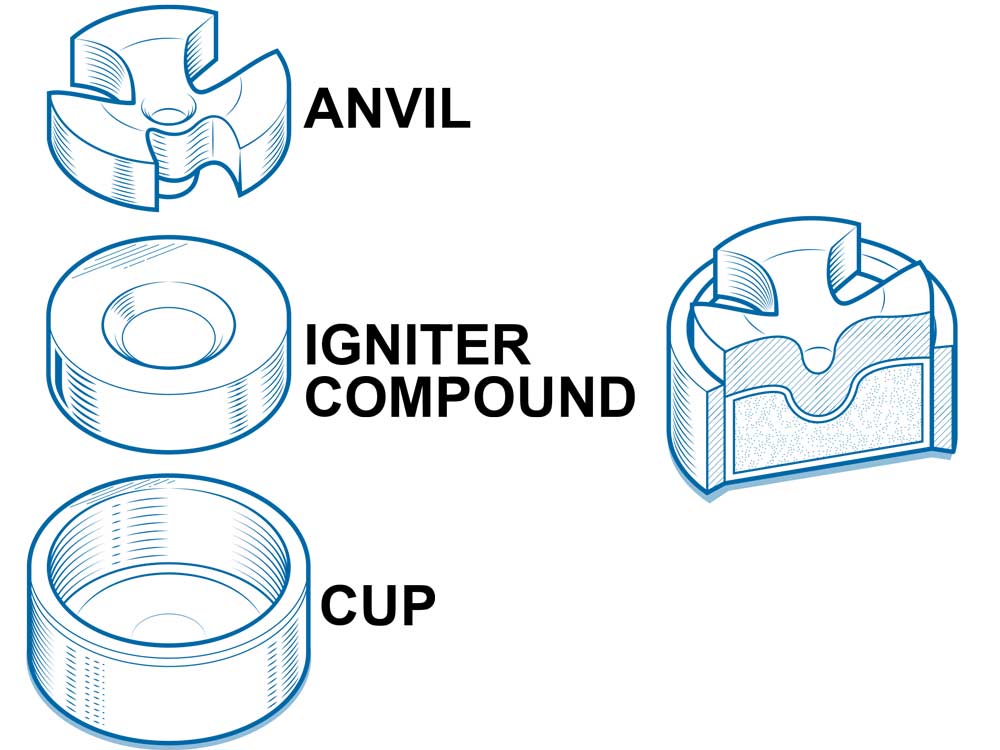Pistol Primers Things To Know Before You Buy
Table of ContentsThe Federal Primers IdeasThe 5-Minute Rule for Primers In StockUnknown Facts About Pistol PrimersFascination About Reloading PrimersThe 8-Minute Rule for Winchester Primers
Element of the firearm cartridge for launching propellant burning In guns and also artillery, the primer () is the chemical and/or device in charge of initiating the propellant burning that will push the projectiles out of the gun barrel. In early black powder weapons such as muzzleloaders, the primer was essentially the very same chemical as the main propellant (albeit usually in a finer-powdered form), yet put into an external flash pan, where it can be fired up by an ignition resource such as a slow-moving suit or a flintlock though some muzzleloaders have primers like cap weapon caps. primers for sale.Instances include handgun cartridges, rifle cartridges, as well as shotgun shells. Larger weapons pieces in contrast generally make use of electric priming. In artillery the primers are regularly a separate component, placed inside the barrel to the rear of the primary propellant chargebut there are various other instances of guns, consisting of for instance some automated weapons, developed to shoot cartridges with indispensable electric guides.
A Biased View of Remington Primers

With the arrival of hand-held guns, this came to be an unwanted way of firing a gun. Holding a burning stick while attempting to pour a charge of black powder thoroughly down a barrel is hazardous, and attempting to hold the gun with one hand while all at once intending at the target and looking for the touchhole makes it very hard to fire precisely. The initial attempt to make the process of firing a tiny arm easier was the "matchlock".
The match was a slow-burning fuse constructed from plant fibers that were soaked in an option of nitrates, charcoal, as well as sulfur, and dried (https://padlet.com/andrewjaeger0217/u7wl4akeskgz50hx). This "slow-match" was sparked before the weapon was required, and it would slowly melt, maintaining a hot ember at the burning end. After the weapon was loaded and the touchhole primed with powder, the burning idea of the match was placed to ensure that the lock would bring it into contact with the touchhole.
Primers For Sale Things To Know Before You Get This
This brought the match down to the touchhole, stiring up the powder - https://www.gaiaonline.com/profiles/relodprim3rs/46047633/. With cautious focus, the slow-burning suit can be kept melting for lengthy durations of time, and also the usage of the lock mechanism made relatively precise fire feasible. The next transformation in ignition modern technology was the "wheel-lock".

The protected flashpan likewise provided some capacity to endure negative climate. primers for sale. Wind, rainfall, and wet weather would provide a matchlock ineffective, but a wheel-lock that was packed and also waterproofed with a little bit of grease around the flashpan could be terminated under most problems. The wheel-lock delighted in just a short period of popularity prior to being superseded by a less complex, more robust style.
The Greatest Guide To Winchester Primers
The flint was held in a spring-loaded arm, called the "dick" from the resemblance of its movement to a pecking poultry. The dick rotated via around a 90-degree arc and also was held in the tensioned, or "cocked" placement by a trigger.
The "half-cock" placement held the cock midway back, as well as utilized a deep notch to make sure that pulling the trigger would certainly not release the penis. Half-cock was a safety and security placement, utilized when loading, storing or bring a packed flintlock. The "full-cock" placement held the dick completely back and was the setting from which the gun was discharged.
It worked as both a flashpan cover and a steel striking surface area for the flint. The frizzen was pivoted and also spring-loaded to ensure that it would certainly secure the open or shut placement. When shut, the striking surface was placed so that the view flint would certainly strike at the proper angle to create a stimulate.
The 6-Minute Rule for Rifle Primers
The flintlock mechanism was less complex as well as stronger than the wheel-lock, and also the flint as well as steel gave a good, trusted resource of ignition. The flintlock stayed in armed forces service for over 200 years, and also flintlocks are still made today for historic re-enactments and also muzzle-loading target competition, and also for seekers that appreciate the extra difficulty that the flintlock provides.
By the middle of the 19th century, the percussion or caplock system was well established., as it was less complex as well as a lot more trusted than the flintlock.
The flashpan and also frizzen were gotten rid of as well as replaced by a little, hollow horizontal cyndrical tube (drum) screwed into the bored-out and also tapped flash opening as well as lugging a "nipple" over which the cap might be fitted. A "hammer" which likewise had half-cock (for loading and using the cap) as well as full-cock settings changed the cock.